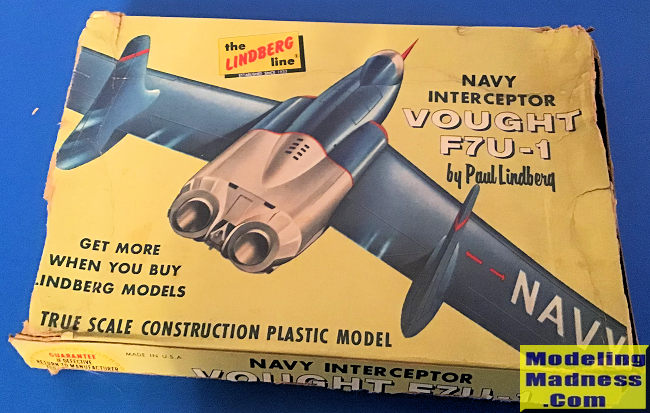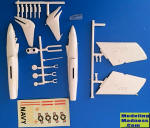
| KIT #: | 437 |
| PRICE: | $0.39 when new ($39.00 shipped today) |
| DECALS: | One option |
| REVIEWER: | Joel Hamm |
| NOTES: | Reportedly 1957 re-boxing from Trim Molds model company. |

| HISTORY |
Vought’s novel design won the competition for the USN’s first post war carrier fighter. Despite company denials, the tail-less configuration was believed based upon, influenced by, or helped along by captured German research data. Numerous, often fatal, design faults; coupled with underpowered engines, led to an unsavory reputation and short service life. Even the Blue Angels demonstration team deemed it unacceptable and it was shouldered aside by the same-company F8U Crusader.
| THE KIT |
 Though the “Ensign Eliminator” inspired little
enthusiasm with the aviators assigned to fly it, the radical shape spurred
interest among the early plastic kit companies, eager to sop up the kiddies’
allowances with rakish, if haphazardly accurate representations of the latest
zoomies. In those bitter-sweet yesterdays of “Father Knows Best” and “Life of
Riley” thirty nine cents was a sum not to be sneered at. Aurora, Revell,
Lindberg, Strombecker, and others cranked out models in 1/48 and various “box
scales”. Then the subject fell into a state of disinterest lasting to the
present.
Though the “Ensign Eliminator” inspired little
enthusiasm with the aviators assigned to fly it, the radical shape spurred
interest among the early plastic kit companies, eager to sop up the kiddies’
allowances with rakish, if haphazardly accurate representations of the latest
zoomies. In those bitter-sweet yesterdays of “Father Knows Best” and “Life of
Riley” thirty nine cents was a sum not to be sneered at. Aurora, Revell,
Lindberg, Strombecker, and others cranked out models in 1/48 and various “box
scales”. Then the subject fell into a state of disinterest lasting to the
present.
A score or so years ago Fujimi issued a series based on the portly and hump-backed Dash Three variant; but except for some vacu-formed and resin attempts, the sexy and futuristic experimental slash early production F7U-1 was unavailable, particularly to modelers dedicated to the proposition that 1”=6’.
Which is why curiosity was generated by an on-line offering for a 1/72 scale Cutlass minted way back in 1957. OldModelKits is a concern that buys up the acquisitions of deceased hoarders and deceased hobby shops for resale to kit collectors, modelers hoping to find that OOP issue they knew they should have bought when it was still available, and those who suffered the misfortune of losing a crate full of stash when it fell off their pickemup truck. Yes – such a catastrophe did befall me several years ago in transit to new quarters. If anyone along Virginia State Routes 3 and 17 came into such windfall, kindly assure me via e-mail that the treasure at least fell into appreciative hands.
Buying ancient kits with the intent to build them is a win-some-lose-some proposition. Box contents can vary considerably from what is advertised, remembered, imagined, or hoped for. The prospect appeared doubtful that it was actually molded in 1/72 scale. In the Duck and Cover Decade that proportion was the convention among kitters in Europe, particularly England, where the recent war made modeling a more adult and therefore respectable pastime.
We stateside whelps knew nothing of constant scale. US companies fed us whatever fit in a standard sized box. The smaller the box, the smaller the price, ergo the smaller the scale. Even if the scale were correct, the quality of the injections could not possibly warrant the effort of correcting all the boogers and would never result in a displayable model.
Nevertheless, retirement and a state of financial comfort afforded by a small fortune nestled in the stock market (I had started with a large fortune) permitted assuaging pangs of curiosity and nostalgia.
Shipping was a bit slow; the owners/operators of OMK surely have paying jobs; but eventual arrival confirmed my first trepidations while dispelling the second. The yellowed end-flap box, held together by a rubber band, had desiccated to the condition in which also was found the Dead Sea Scrolls. The innards were secured in a modern Zip Lock and, except for the discolored decal sheet, had endured unaffected by the eons.
Superimposition on the Fujimi sprues verified that the size was smaller than 1/72. A recent Forums contributor pegged it at 1/96. The injection quality was much better than I had expected – or, considering the era of its formation, had a right to expect.
General shape appears accurate and level of detail adequate. Overdone but acceptable raised panel lines. Crisp, hard, firm, smooth, thin white plastic. Odd color because models at that time were molded in the color of the finished airplane; the better to save us waifs the task, and expense, of brush painting square bottle enamels that never dried; and to spare Moms the horror of having to scrub said enamels from furniture, carpet, floors, and faces.
Only a hint of flash on the wing panels, which are molded solid. A very shallow ejector dot on each of same. No sink / shrink holes other than shallow dimpling at the thickest part of the solid tail fins. Easily fixed now with a tad of JB Weld or Bondo; though at time of manufacture plaster of paris may have been the only available filler.
 Fuselage halves fit together flawlessly with the aid
of locating pins and sockets. If they could do that in 1957 why can’t they do it
now? The cockpit is the typical for the time walled off type with minute blobs
representing a shrunken pilot’s head, seat back, and HUD; easily cut away and
replaced with something resembling a seat and interior.
Fuselage halves fit together flawlessly with the aid
of locating pins and sockets. If they could do that in 1957 why can’t they do it
now? The cockpit is the typical for the time walled off type with minute blobs
representing a shrunken pilot’s head, seat back, and HUD; easily cut away and
replaced with something resembling a seat and interior.
The canopy is cataracted but still thinner and clearer than anything contemporary Airfix or Frog produced; or that which some short runners still pawn off half a century later. A polishing and dunk in Future/Kleer might bring it to current standards; or it could be used to vacu-suck or thermo-smash a replacement.
No attempt is made to represent wheel wells but with little difficulty they could be carved out. The sprues hold properly shaped and thin nose wheel doors, but the mains are close-but-no-cigar nubbins that would need to come from the spares bin.
Wheels are wheels and not shirt collar buttons; properly proportioned with delicately engraved spoking on both sides. Molded separate from the struts, they are meant to snap onto axle pins in the forks so they can rotate. Spinning wheels and propellers were a must on even the smallest and simplest models of the time.
Operating features were a big draw because models were meant to play with, not sit on a shelf. Both Monogram and Lindberg offered large scale Avengers with turrets and guns that moved, gear that retracted, canopies that slid, bombs that dropped, and even control surface that were linked to a working joy stick in the cockpit.
Rockets! None of the scadzoolion GOOGLE photos suggests that the Cutlass carried rockets; but any urchin handing his thirty nine cents across the toy store counter expected his model airplane to have rockets. So there they are – six indistinct matchsticks mated to slabs – not pylons – slabs!, by which to stick them into slots in the wing. All can be deleted, filled, and sanded smooth.
| CONCLUSIONS |
Surprising quality for prehistoric moldings. Pity it’s not 1/72. I may have to break from my constant scale analism and put together this puppy.
Joel Hamm
January 2020
Copyright ModelingMadness.com.
If you would like your product reviewed fairly and fairly quickly, please contact the editor or see other details in the Note to Contributors.
Back to the Main Page Back to the Review Index Page Back to the Previews Index Page